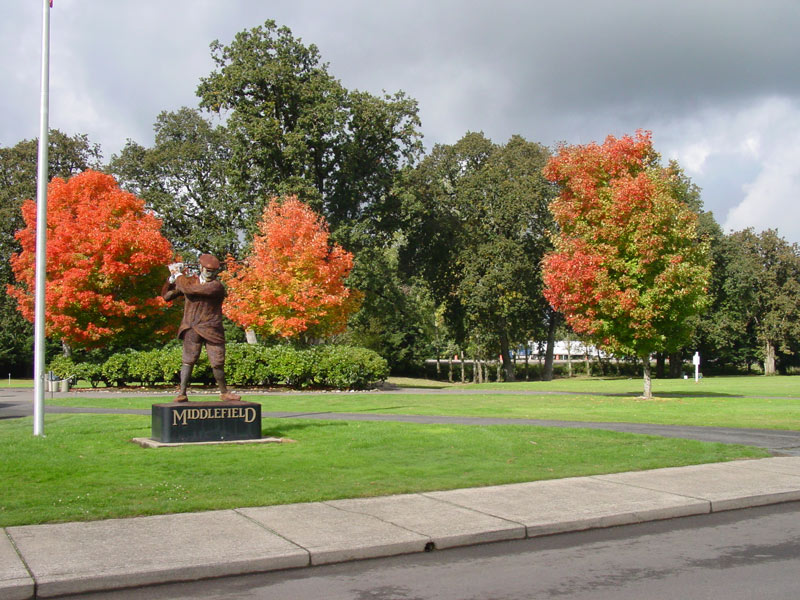
Homegrown help: The city of Cottage Grove, Ore., needed to look no further than local Middlefield Golf Course to tackle an effluent water concern, and superintendent and Cottage Grove native Kris Ammerman played a part in making the plan a reality. Photo by Kristin Ammerman
Middlefield Golf Course is often referred to by patrons as a fun little course, and by passersby as a beautiful introduction to the small town of Cottage Grove in western Oregon. Middlefield is fun — I can attest to that. I’ve played the course on a regular basis since it opened in 1991. And it is literally a welcome mat, as Interstate 5 runs right through the middle of it, making the course the first thing many travelers see as they arrive in our small town, which was once rooted in the mining and logging industries. Compared with today’s behemoth golf courses, Middlefield is also small. The 18-hole executive course measures just 5,200 yards.
In late 2006, the city of Cottage Grove purchased Middlefield Golf Course. Now, I know that a municipality owning a golf course isn’t exactly a groundbreaking endeavor, but this particular transaction was far more than just a land sale agreement. This fun little golf course was about to save Cottage Grove roughly $1 million, and allow for the conservation of 50 million gallons of water every year.
A proactive proposal
The city’s interest in acquiring the previously privately owned golf course stemmed from its need to solve a pending wastewater woe. At the time of purchase, the city was discharging its effluent water into a temperature-limited stream (the Coast Fork of the Willamette River). With future tightening of government regulations regarding the temperature and phosphate level of treated water discharged into the river system, though, that was not going to be an option indefinitely. One proposed alternative was to build a cooling tower to cool the effluent water during the summer months before releasing it into the stream. The projected cost to construct the tower was in excess of $1 million — an amount that prompted the city to begin looking at other solutions.
Around that time, Cottage Grove city manager Richard Meyers approached me to inquire about the feasibility of purchasing the golf course and using the reclaimed water to irrigate it. The cost of buying Middlefield — which is about a quarter-mile from the city’s wastewater treatment plant — was estimated to be less than that of building a cooling tower, and the course would also become a city asset.
I was working at my family’s small auto body repair business at the time, and had formerly been the assistant superintendent at Aspen Lakes Golf Course in Sisters, Ore., for four years. I’d met Richard after moving back to my hometown of Cottage Grove in 2003. When the city began contemplating buying Middlefield, Richard, aware of my background in the golf industry, started coming to me with questions.
Looking back, I have to admit that I didn’t know nearly as much as I thought I did about irrigating with effluent water. My confidence was high then, however, because I’d recently attended the Golf Industry Show in Orlando, where I’d spent half a day touring prestigious golf courses that use effluent water for their irrigation. I figured that if they could do it and still maintain a high level of playability, then we could too.
Retrofitting for effluent irrigation
In April 2007, I transitioned from being a consultant to the full-time golf course superintendent at Middlefield. By this time, the groundwork to equip the course’s irrigation system to accommodate the city’s effluent water was in full swing. The irrigation system itself remained the same, but new piping and valves were needed to get the water from the wastewater treatment plant to the golf course’s irrigation pond. All piping was installed on city property, so no other landowners were involved, and the golf course and wastewater treatment plant being in such close proximity to each other kept the infrastructure costs down. Play at Middlefield never ceased throughout the water source conversion.
Before making the switch, I’d sought advice from fellow superintendents who were already employing effluent water for irrigation. Some superintendents in arid regions recommended flushing the system once a month or so to prevent salt and bicarbonate buildup in the soil (given that we get 40 to 50 inches of rain here annually, that’s not something I anticipated us having trouble with, though). A suggested preliminary step was to post signs at certain tees and around the irrigation pond that state that reclaimed water is in use and that drinking and swimming are thus prohibited, which we did.
Thanks to a hardworking and efficient public works crew, the setup connecting the city’s wastewater treatment plant to Middlefield’s irrigation reservoir was functionally ready in 2008. Believe it or not, the physical work of trenching and installing pipe and valves wasn’t the toughest part of the process. (Easy for me to say, right? I didn’t have a shovel in my hand.) On my end, as superintendent, the most time-consuming aspect was attaining the necessary National Pollutant Discharge Elimination System (NPDES) permit. Because of backlogs caused by issues with the federal EPA, the Oregon Department of Environmental Quality has been slow in issuing these permits, and Middlefield’s effluent irrigation system wasn’t cleared for lawful operation until 2010. Finally, in June 2010, permit in hand, we were ready to go online with our transformed irrigation setup.
Reaping the rewards
The day-to-day operation of Middlefield’s effluent irrigation system is basically the same as any other golf course irrigation system. The only real difference is how closely we have to watch the level of water in our irrigation pond (which is about an acre in size) to ensure it doesn’t overflow and discharge wastewater into the river system. This requires frequent checking, reporting and communication with the wastewater treatment plant during the season. I call the plant daily to discuss the reservoir’s supply and the course’s short-term water use plans, and a plant employee typically visits the course to inspect the pond level after the golf course staff has gone home for the day. A larger pond to hold our effluent irrigation water would help alleviate this issue, but we haven’t yet been able to work that expense into the budget. For now, we just diligently monitor our water use and the pond level.

Designed by Gene Mason and opened in 1991, Middlefield GC has been owned and operated by the city of Cottage Grove, Ore., since 2006. Following an irrigation system retrofit, the course has been able to take on about 50 million gallons of the city’s effluent water every year since 2010. Photo courtesy of the city of Cottage Grove
There were some kinks and wrinkles in the system in the beginning, but we’ve carefully tracked inefficiencies and made adjustments wherever necessary. It’s not a perfect system, but none is, especially not retrofitted ones. Effluent irrigation has worked well for us, though, and it has also yielded some very tangible benefits:
- Approximately 50 million gallons of fresh water conserved at Middlefield every irrigation season
- Approximately 50 million gallons of the city’s wastewater diverted from the river system every year and given a second purpose as irrigation for green space
- Greener grass, resulting in a 30 percent cut in fertility expenses (Middlefield has a perennial rye/annual bluegrass mix on its fairways, and greens are a creeping bentgrass/Poa annua mix)
- Contaminants in effluent water, such as nitrates and phosphates, are nutrients to turfgrass, which filters them out of the water, preventing pollution and improving water quality Initial cost savings of $1 million for the city of Cottage Grove
All inclusive
The evolution that has taken place at Middlefield Golf Course throughout the past 10 years has had a positive impact on Cottage Grove from both an environmental and a community standpoint. Along with shifting to effluent water to maintain the golf course, we’ve introduced soccer golf and disc golf to Middlefield’s list of offerings. The property also boasts a perimeter cart path that’s open to bikers, joggers and walkers. The route provides excellent views of several acres of woodlands and wetlands, making it a great spot for bird-watchers and wildlife lovers.
We’ve added all of these amenities with the goal of increasing community use of the space and sharing Middlefield’s beautiful blend of well-maintained landscape and the natural terrain with more people. Many golf courses are all about exclusivity, but Middlefield isn’t one of them. Our facility will never be mistaken for a country club, and that’s fine with us. In an extensive effort to grow the game of golf and also promote personal health and wellness, we invite everyone to come out and enjoy the course and its spectacular surroundings.
For those looking to potentially save a job, a golf course, a green space, a million dollars, a watershed or all of the above, consider switching your course to effluent irrigation. The greatness of golf extends beyond the game itself in that golf courses and the people who manage them can be conduits of responsible, important environmental stewardship. Middlefield, like thousands of other golf courses around the world, not only offers recreation, but conserves water, helps protect water quality, and preserves and enhances our planet’s valuable and finite open spaces.
Kris Ammerman is the parks/golf course superintendent for the city of Cottage Grove, Ore. A 16-year member of GCSAA, he has served on the board of directors of the Oregon GCSA and was its chapter delegate in 2012. Kris is a 1998 graduate of Oregon State University’s turf and landscape management program. He lives in Cottage Grove with his wife, Kristin, and their three boys, Brogan, Lincoln and Dallin.